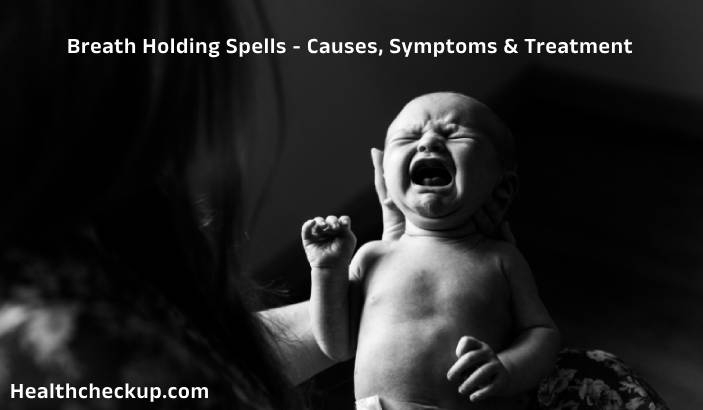Breath-holding spells (BHS) are frightening episodes where an individual, often a child, stops breathing for a short period. These spells are most common in infants and young children, but they can occasionally be seen in adults. Understanding the causes, symptoms, and management of breath-holding spells is crucial for parents, caregivers, and healthcare providers.
What Are Breath-Holding Spells?
Breath-holding spells are involuntary pauses in breathing that typically occur in response to pain, frustration, anger, or fear. During a spell, a child cries or screams and then stops breathing, often leading to a brief loss of consciousness. These episodes can be alarming but are generally benign and self-limiting.
Types of Breath-Holding Spells
Breath-holding spells are classified into two main types: cyanotic and pallid.
- Cyanotic Breath-Holding Spells
- Description: The most common type, these spells are triggered by emotions such as anger or frustration. The child typically cries hard, turns blue (cyanotic), and then stops breathing.
- Symptoms: The child becomes limp and loses consciousness for a short time. Recovery is usually rapid, with the child returning to normal behavior shortly after the episode.
- Pallid Breath-Holding Spells
- Description: Less common than cyanotic spells, these are often triggered by a sudden scare or minor injury.
- Symptoms: The child turns pale (pallid), stops breathing, and loses consciousness. The episode is followed by brief twitching or convulsions, resembling a seizure.
Causes of Breath-Holding Spells
The exact cause of breath-holding spells is not entirely understood, but several factors are believed to contribute:
- Immature Nervous System: In infants and young children, the nervous system is still developing, which can result in exaggerated responses to emotional stimuli.
- Genetic Predisposition: Breath-holding spells can run in families, suggesting a genetic component.
- Iron Deficiency: Some studies have linked iron deficiency anemia to an increased frequency of breath-holding spells. Supplementing iron reduces the occurrence of spells.
- Emotional Triggers: Intense emotions, such as anger, frustration, pain, or fear, can trigger an episode.
Breath-Holding Spells in Newborns and Infants
Breath-holding spells are most common in children aged 6 months to 6 years, with peak incidence around 2 years of age. While newborns can experience breath-holding spells, it is less common and often associated with underlying medical conditions.
Symptoms in Newborns and Infants
- Crying Followed by Breath-Holding: The infant cries intensely, then stops breathing.
- Color Change: The infant’s skin turns blue (cyanosis) or pale (pallor).
- Loss of Consciousness: The infant loses consciousness briefly and becomes limp.
- Rapid Recovery: Most infants recover quickly and return to normal behavior after the spell.
Management and Treatment in Infants
- Stay Calm: It is crucial for parents and caregivers to remain calm during a breath-holding spell. Panicking can exacerbate the situation.
- Lay the Child Down: Place the child on their side in a safe location to prevent injury during the spell.
- Monitor Breathing: Ensure the child resumes normal breathing after the episode. If the child does not start breathing within a minute, seek emergency medical help.
- Consult a Pediatrician: Frequent or severe spells warrant a consultation with a pediatrician. The doctor recommends tests to rule out underlying conditions and check for iron deficiency.
- Iron Supplementation: If iron deficiency is identified, iron supplements reduces the frequency of breath-holding spells.
Breath-Holding Spells in Adults
While rare, adults can experience breath-holding spells. These episodes in adults are often related to underlying medical conditions or psychological factors.
Symptoms in Adults
- Breath-Holding: Adults consciously or subconsciously hold their breath during periods of intense stress, fear, or anger.
- Color Change: As with children, the skin turns blue or pale.
- Loss of Consciousness: Adults faint if the spell is prolonged.
Causes in Adults
- Psychological Factors: Stress, anxiety, and panic attacks can lead to breath-holding spells.
- Medical Conditions: Conditions such as epilepsy, syncope (fainting), or hyperventilation syndrome can mimic breath-holding spells.
Management and Treatment in Adults
- Identify Triggers: Understanding and avoiding triggers can help manage breath-holding spells.
- Stress Management: Techniques such as deep breathing exercises, meditation, and counseling can reduce the frequency of spells.
- Medical Evaluation: A thorough medical evaluation is necessary to rule out underlying conditions. Treatment will depend on the diagnosis.
- Medication: If an underlying medical condition is identified, appropriate medication are prescribed.
Complications of Breath-Holding Spells
While breath-holding spells are generally harmless, they can occasionally lead to complications:
- Injuries: A child may fall and injure themselves during a spell. Ensuring a safe environment can help prevent injuries.
- Seizures: In rare cases, breath-holding spells can trigger seizures. These are typically brief and resolves on their own.
- Impact on Family: The episodes can be distressing for parents and caregivers. Education and support are essential to manage anxiety and fear.
When to Seek Medical Help
It is important to seek medical advice if:
- Frequent Spells: The child experiences breath-holding spells frequently.
- Prolonged Episodes: The episodes last longer than a minute or the child does not recover quickly.
- Severe Symptoms: The child experiences seizures, significant injury, or prolonged loss of consciousness.
- Concerns About Development: There are concerns about the child’s overall development or behavior.
Summing Up
Breath-holding spells can be alarming but are usually benign and self-limiting. Understanding the types, causes, symptoms, and management of breath-holding spells can help parents, caregivers, and healthcare providers handle these episodes effectively. While most children outgrow breath-holding spells by the age of 6, ongoing research and medical advancements continue to provide insights into the best practices for managing this condition.
I specialize in writing about health, medical conditions, and healthcare, drawing extensively from scientific research. Over the course of my career, I have published widely on topics related to health, medicine, and education. My work has appeared in leading blogs and editorial columns.









